

For brands
Offer excellent operations
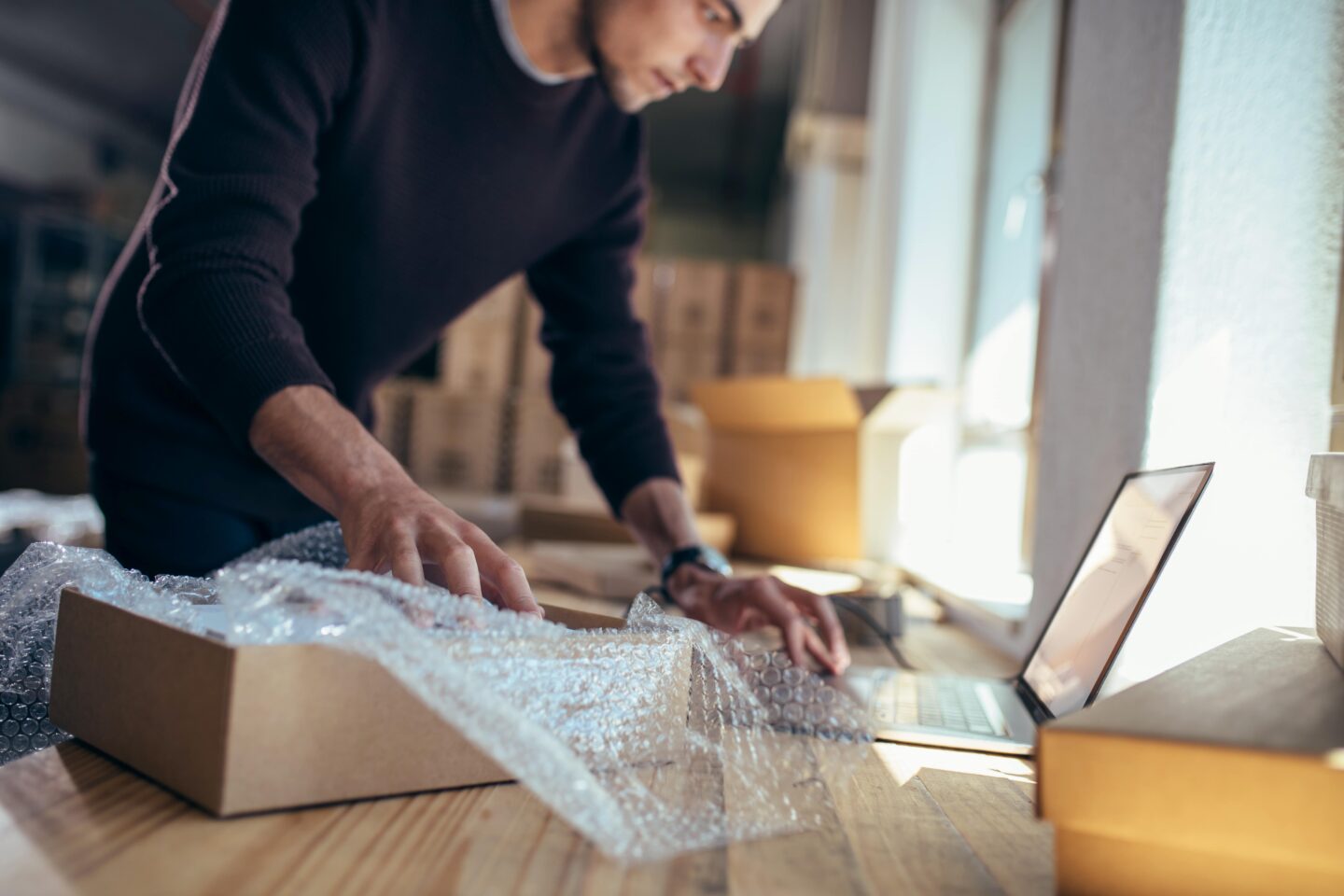
How to pack your parcels to avoid damaged products: 5 tips from our logistics experts
26 April 2024
Say goodbye to breakage and damaged products! In today’s fast-paced retail environment, ensuring your parcels arrive intact is crucial for maintaining strong relationships with independent retailers. Our logistics experts have distilled their knowledge into five essential steps that not only reduce breakage but also boost your retailers’ confidence in your brand.
As a brand, you understand the profound impact that product delivery has on your customers’ overall experience. Ensuring that your products arrive intact and undamaged is crucial for maintaining customer satisfaction and loyalty. To help you provide a 5-star delivery experience for your retailers, our logistics experts have crafted a comprehensive guide. Follow these essential steps to minimise the risk of breakage and damage, ensuring your products are received in perfect condition and delighting your retailers every time.
1. Choose the right packaging for your parcel
Packaging durability
Firstly, you must establish product type details and how it could be affected when shipped. Is it fragile? What material is it made of? Is it heavy? Is it inflated and can burst? Take time to think of potential complications.
Next, consider packaging options that match the needs of the product type. A fragile product needs strong packaging, whereas an unbreakable product (like textiles) can be sent in a plastic pouch.
There are various packaging options: pouches, tubes, cardboard boxes, crates, etc. It is, therefore, necessary to define which packaging best suits the product.
The qualities of resistance will be determined by the weight and type of product, for example single, double or triple flute.
Expert tip: always bear in mind that between the place of dispatch and the recipient, packages will be handled, stacked, loaded and unloaded with varying degrees of care.
Packaging dimensions
It is essential that the size of the packaging is well-adapted to the product to ensure the parcel is sufficiently protected.
- If the box is too big, the product is likely to move around while being handled, increasing the risk of damage. (There will likely also be an excessive use of cushioning material, which is not an environmentally friendly option.)
- If packaging is too small, it won’t provide sufficient protection and you run the risk of the product being deformed, distorted, dented, bent or broken.
For the optimal solution and protection, choose packaging that is slightly larger than the product (approximately 2 cm more in height, length and width).
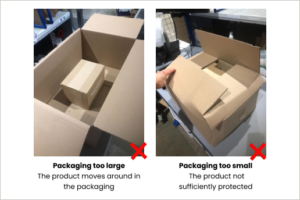
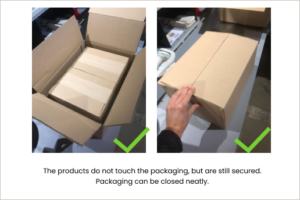
2. Add cushioning material to the parcel
Several solutions for cushioning exist depending on the type of product:
Dividers
These are preferable for products like beverages or spreads in glass containers and tableware, mainly sold in batches. Using appropriately designed dividers prevents the products from damaging each other during shipment.
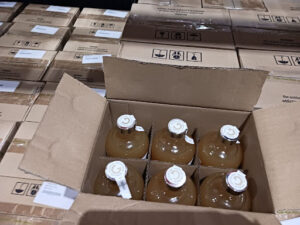
Shredded paper or wood and polystyrene beads
It is advisable to cushion fragile single products with shredded paper or shredded wood to absorb shocks. For hollow products (like cups, ceramic vases or glasses) it is advisable to add shredded or kraft paper inside as well to reinforce the cushioning effect.
Bubble wrap
Bubble wrap is an excellent choice for very fragile products that need extra protection.
Kraft paper and air cushions
Kraft paper and air cushions should be used for less fragile products, as they are less shock absorbent and allow for some movement.
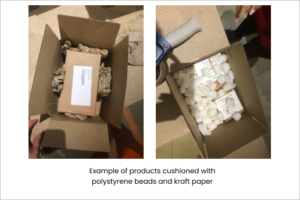
3. Place the products in the parcel correctly
Placing the products in the correct outer box for shipping
As mentioned in the previous section on “packaging dimensions”, it is important to choose the right size box from the outset, and not one that is too big or too small.
Product positioning
There are several possible scenarios. There may be just one product to pack, or several to put in the same box.
For one product, ensure it is centred and carefully cushioned around the sides.

For several products (which may vary in size) make sure you place the heaviest at the bottom of the box to avoid damaging the lighter products. Place the other products around the heavy object, then on top.
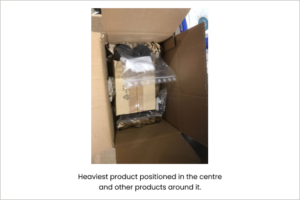
Expert tip: For a multi-product parcel containing a heavy product that must be placed at the bottom to avoid damaging the others during transport, it is essential to indicate the top of the box to the carriers. This can be done manually with a felt-tip pen or marker but will be more visible with a sticker.
4. Protect products from moisture damage
To avoid an unpleasant surprise for your retailers when they unbox your products — consider adding silica gel to the parcel to reduce humidity in textile and ceramic products to help prevent mould or cracks.
5. Close and seal the parcel sufficiently
Here’s how to ensure your products are sealed sufficiently:
Quality adhesive tape
Poor-quality adhesive tape might peel off during transport, resulting in damage to the parcel and possible breakage or loss of goods. Choose an adhesive tape that sticks well and does not tear easily.
Expert tip: We recommend tape width of at least 5 cm to ensure the box stays closed and secure.
Type of sealing
There are different ways of sealing a box with adhesive tape:
- L-shaped: for light products
- U-shaped: for heavy products or the transport of light products that will go through several stages of routing
- Combined L and U: for transporting heavy products over long distances (international orders)
- H: a highly secure method suitable for all products
Expert tip: We recommend the H method to ensure effective sealing for all product types
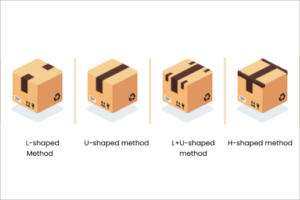
Shipping labels
For the shipment to go as smoothly as possible, the parcel must be properly labelled:
- On the document pocket, the recipient’s and sender’s addresses must be clearly visible, as well as the barcode.
- If there are fragile products in the parcel, add the “Fragile” and “Top Position” labels to warn the carriers so that they can take precautionary measures during transit.
“Fragile” and “Top Position” labels can be found on the following document to print and paste on the parcel:
By following these 5 steps meticulously, you can be sure of offering your retailers an unrivalled delivery experience, and ensuring a long-term relationship based on trust.


